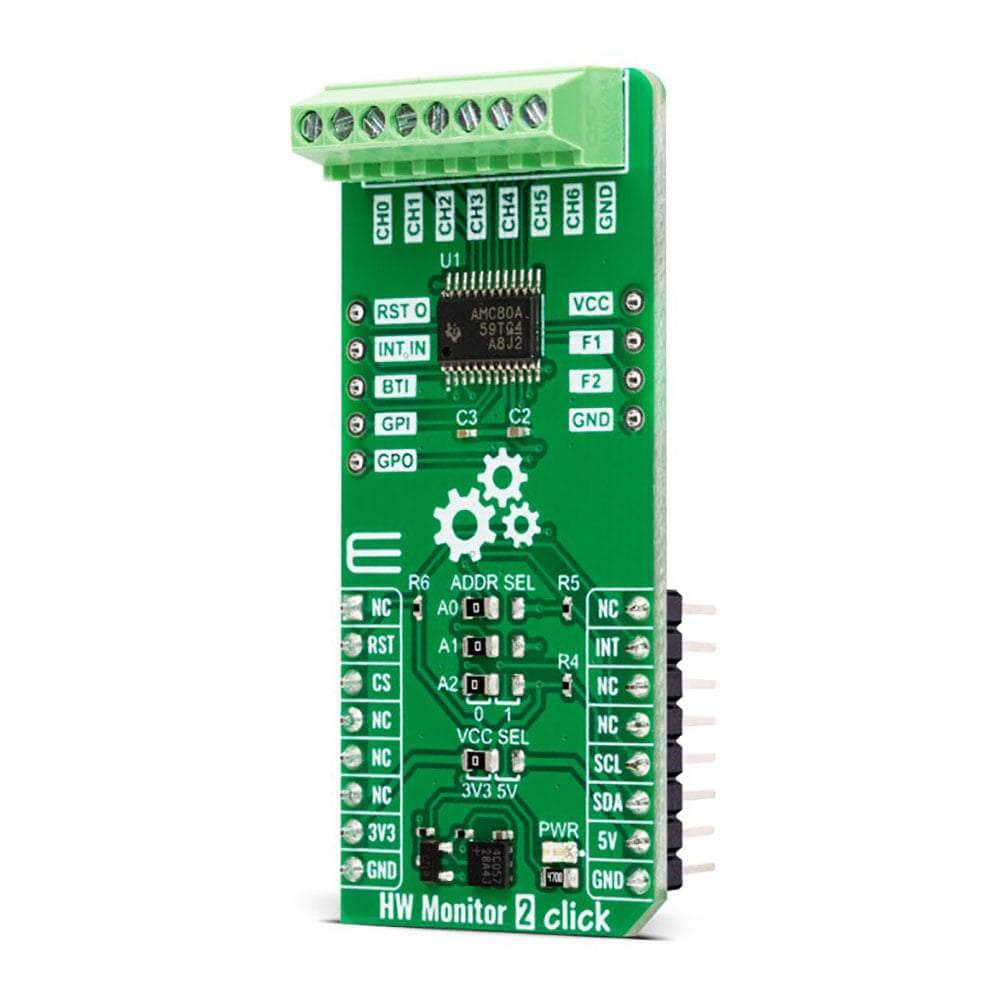
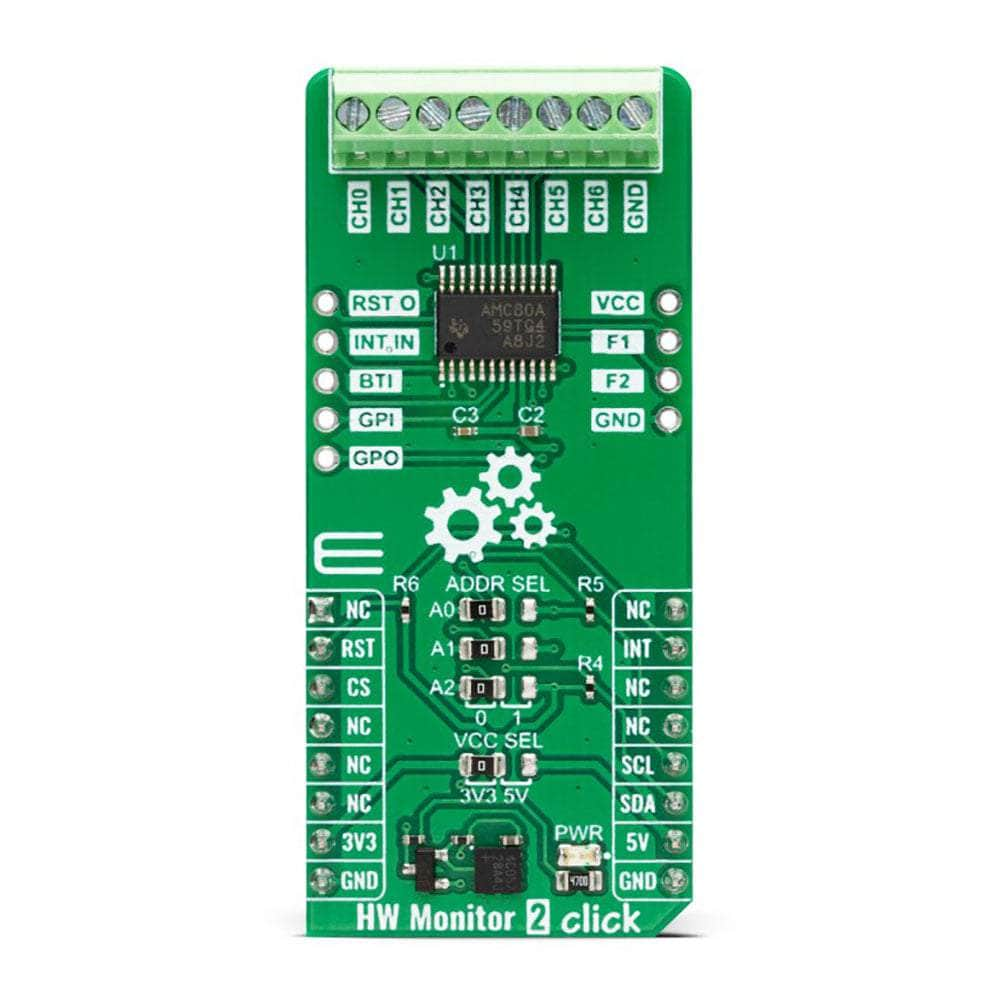
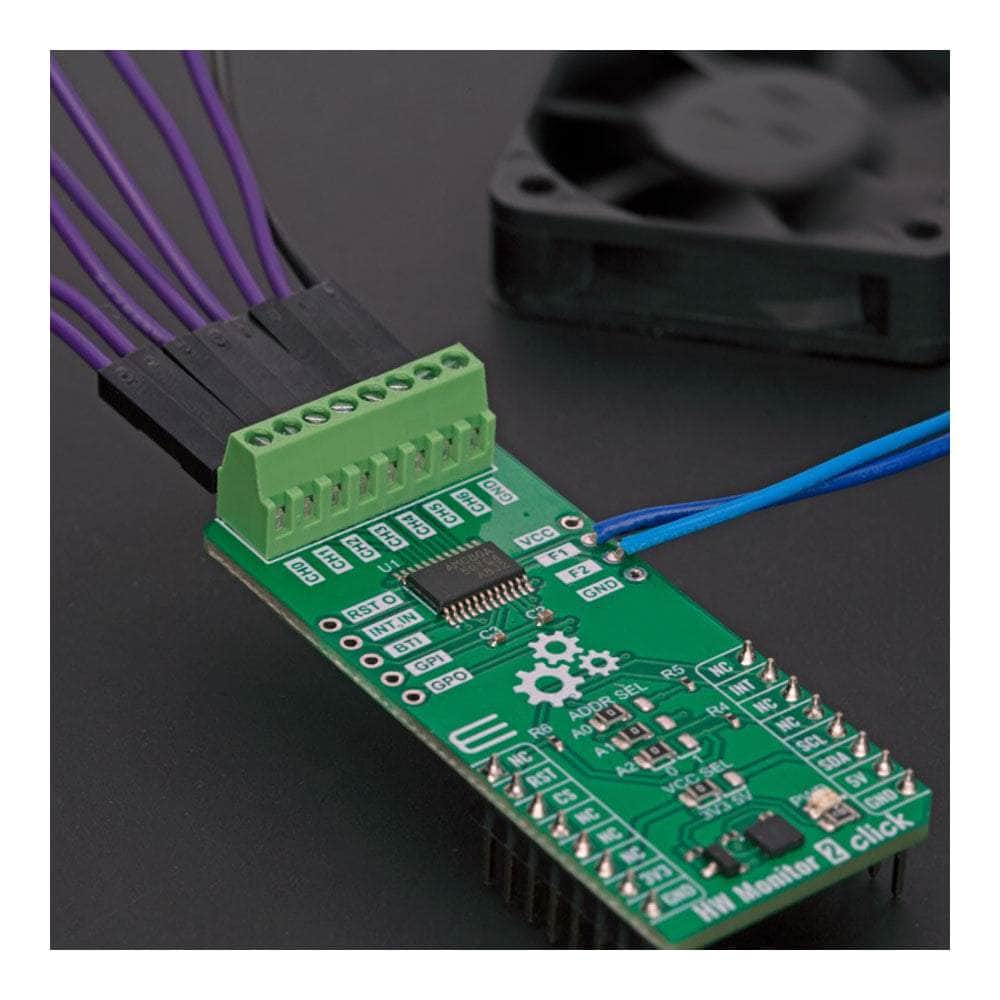
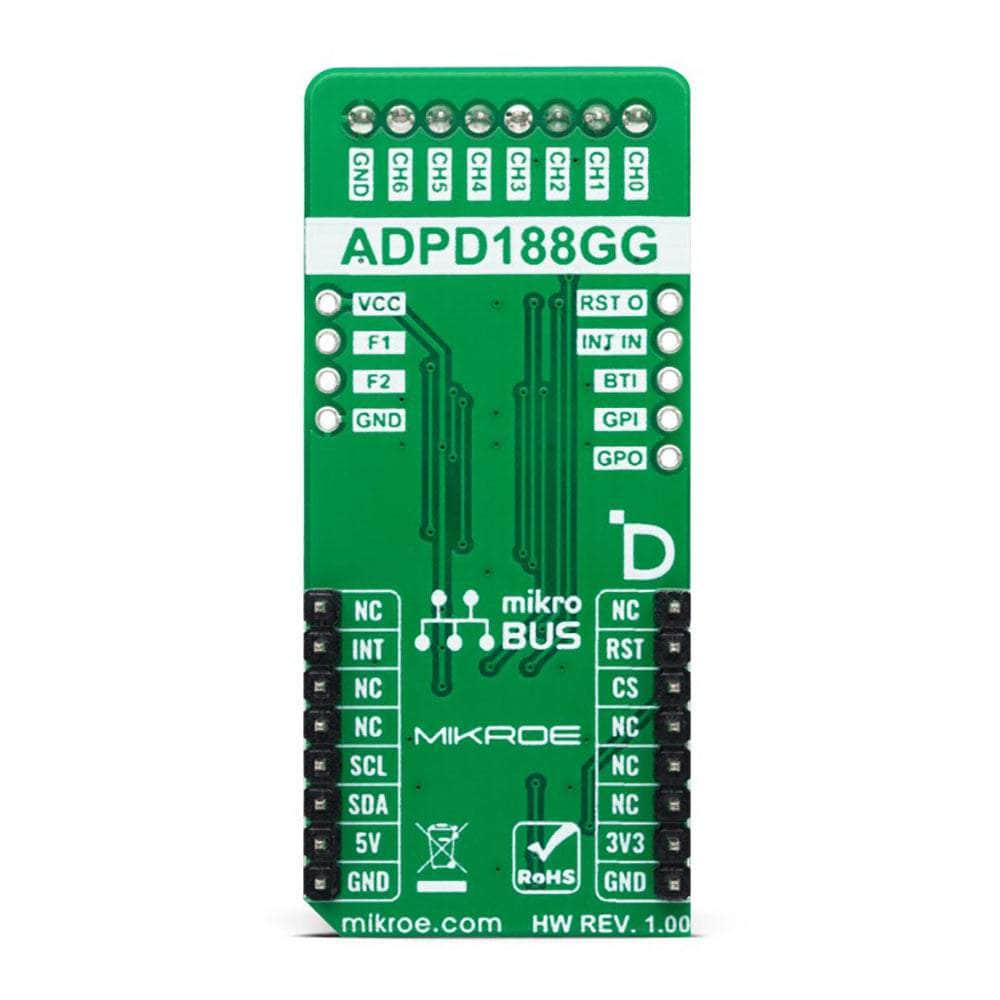
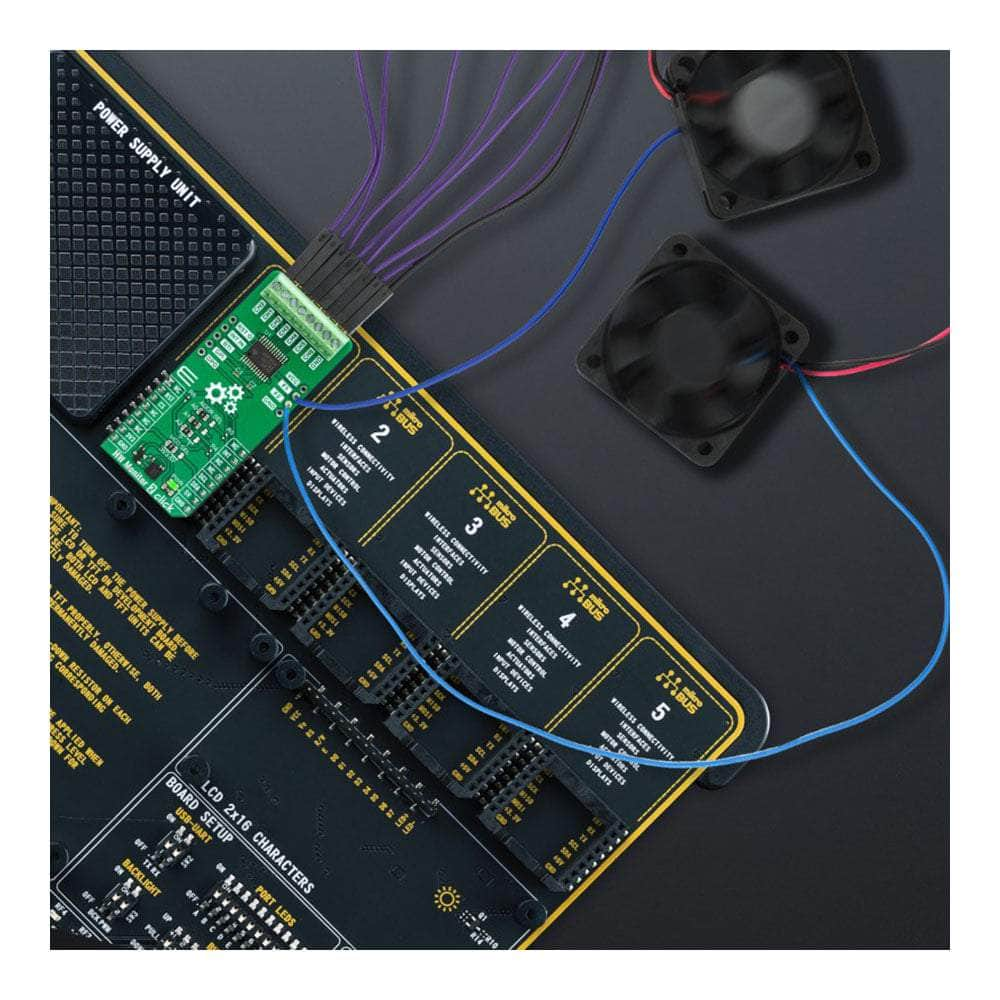
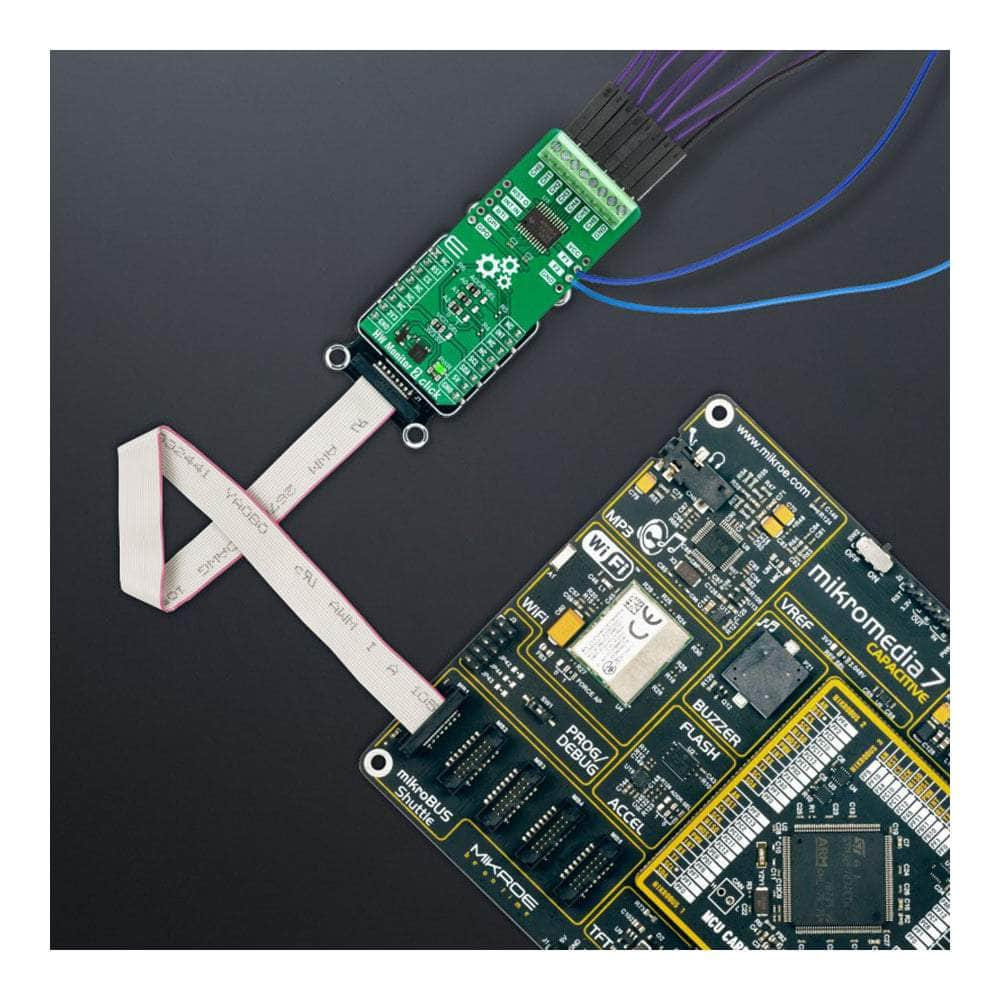

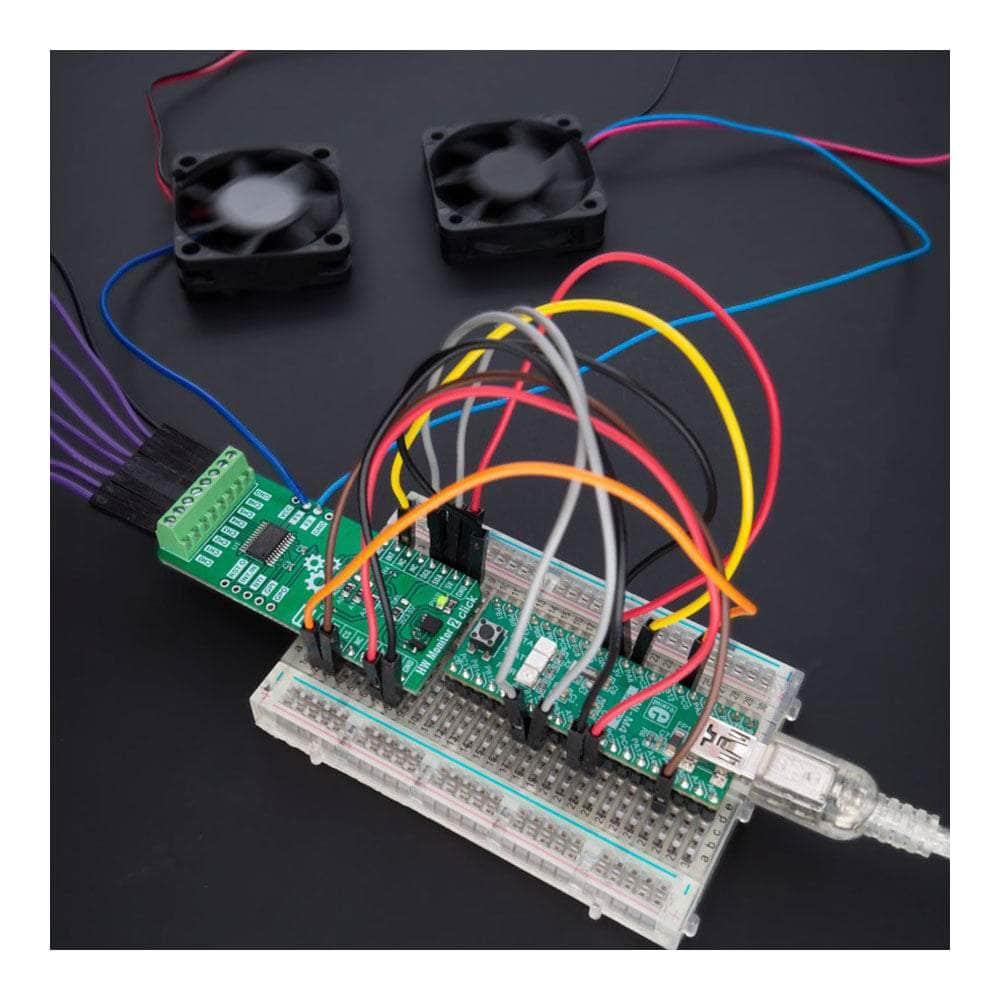
How Does The W Monitor 2 Click Board™ Work?
The HW Monitor 2 Click Board™ is based on the AMC80, a system hardware monitor from Texas Instruments that performs power supply, temperature, and fan monitoring for various embedded systems. The AMC80 provides seven analogue inputs spread across the terminals on the top of the board labelled CH0 to CH6, a temperature sensor, an ADC, two fan speed counters, and various inputs and outputs on a single chip. It continuously converts analogue inputs to 10-bit resolution with a 2.5mV LSB, yielding input ranges of 0 to 2.56V. The analogue inputs are intended to connect to several power supplies in a typical communications infrastructure system.
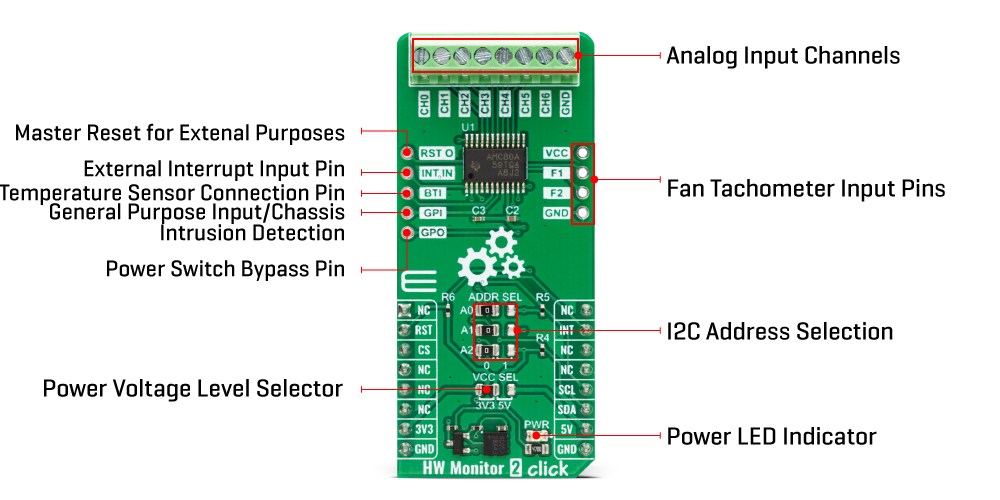
This Click board™ communicates with MCU using the standard I2C 2-Wire interface to read data and configure settings with a maximum frequency of 400kHz. The AMC80 includes an analog filter on the I2C lines that improves noise immunity and supports the timeout reset function on SDA and SCL pins, preventing I2C bus lockup. Also, the AMC80 allows choosing the least significant bits (LSB) of its I2C slave address using the SMD jumpers labelled ADDR SEL.
The AMC80 is especially suited to interface with linear and digital temperature sensors such as TMP75 via the BTI pin on the left unpopulated header. Temperature can be converted to a 9-bit or 12-bit two's complement word with resolutions of 0.5°C or 0.0625°C LSB, respectively. On the same header, in addition to the BTI pin, there is also a GPI pin, which, in addition to its function as a general-purpose input pin, can also serve as a chassis intrusion detection input. The chassis intrusion input is designed to accept an active high signal from an external circuit that latches, such as when the cover is removed from the computer.
Next in this board's additional features are an external interrupt input INT IN, a master reset for external purposes RST O, and a single power switch pin GPO. The INT IN active low interrupt provides a way to chain the interrupts from other devices through the AMC80 to the host, the RST O is intended to provide a master reset to devices connected to this line, while the GPO pin is an active low NMOS open drain output intended to drive an external power PMOS for software power control or can be utilized to control power to a cooling fan. The AMC80 also possesses a general reset signal routed on the RST pin of the mikroBUS™ socket to reset the AMC80, and an additional interrupt signal, routed on the INT pin of the mikroBUS™ socket whenever some of the external interrupts like INT_OUT, interrupt from the temperature sensor, or when a chassis detection event occurs.
The right-side header contains the fan inputs, labelled F1 and F2, that can be programmed to accept either fan failure indicator programmed to be active high or active low or tachometer signals. Fan inputs measure the period of tachometer pulses from the fans, providing a higher count for lower fan speeds. The full-scale fan counts are 255 (8-bit counter), representing a stopped or slow fan. Based on a count of 153, nominal speeds are programmable from 1100 to 8800 RPM. Signal conditioning circuitry is also included to accommodate the slow rise and fall times.
The W Monitor 2 Click Board™ can operate with either 3.3V or 5V logic voltage levels selected via the VCC SEL jumper. This way, both 3.3V and 5V capable MCUs can use the communication lines properly. However, the Click board™ comes equipped with a library containing easy-to-use functions and an example code that can be used, as a reference, for further development.
SPECIFICATIONS
| Type | ADC |
| Applications | It can be used for system thermal and hardware monitoring for various servers, electronic test equipment and instrumentation, communications infrastructure, consumer electronics, and more |
| On-board modules | AMC80 - system hardware monitor from Texas Instruments |
| Key Features | Seven input channels with 10-bit resolution, local temperature sensing, two programmable fan speed monitoring inputs, chassis intrusion detection, power switch bypass, external interrupt and master reset, and more |
| Interface | I2C |
| Compatibility | mikroBUS |
| Click board size | L (57.15 x 25.4 mm) |
| Input Voltage | 3.3V or 5V |
PINOUT DIAGRAM
This table shows how the W Monitor 2 Click Board™ pinout corresponds to the pinout on the mikroBUS™ socket (the latter shown in the two middle columns).
| Notes | Pin |  |
Pin | Notes | |||
|---|---|---|---|---|---|---|---|
| NC | 1 | AN | PWM | 16 | NC | ||
| Reset | RST | 2 | RST | INT | 15 | INT | Interrupt |
| NC | 3 | CS | RX | 14 | NC | ||
| NC | 4 | SCK | TX | 13 | NC | ||
| NC | 5 | MISO | SCL | 12 | SCL | I2C Clock | |
| NC | 6 | MOSI | SDA | 11 | SDA | I2C Data | |
| Power Supply | 3.3V | 7 | 3.3V | 5V | 10 | 5V | Power Supply |
| Ground | GND | 8 | GND | GND | 9 | GND | Ground |
ONBOARD SETTINGS AND INDICATORS
| Label | Name | Default | Description |
|---|---|---|---|
| LD1 | PWR | - | Power LED Indicator |
| JP1 | VCC SEL | Left | Power/Logic Voltage Level Selection 3V3/5V: Left position 3V3, Right position 5V |
| JP2-JP4 | ADDR SEL | Left | I2C Address Selection 0/1: Left position 0, Right position 1 |
| J1 | - | Unpopulated | Fan Tachometer Input |
| J2 | - | Unpopulated | Master Reset/External Interrupt/Temperature Sensor Connection/Chassis Intrusion Detection/Power Switch Bypass |
HW MONITOR 2 CLICK ELECTRICAL SPECIFICATIONS
| Description | Min | Typ | Max | Unit |
|---|---|---|---|---|
| Supply Voltage | 3.3 | - | 5 | V |
| Analog Input Voltage Range | 0 | - | 2.56 | V |
| ADC Resolution | - | 10 | - | bit |
Software Support
We provide a library for the W Monitor 2 Click Board™ and a demo application (example), developed using MIKROE compilers. The demo can run on all the main MIKROE development boards.
The package can be downloaded/installed directly from NECTO Studio The package Manager (recommended), from our LibStock™ or found on the MikroE Github account.
Library Description
This library contains API for the W Monitor 2 Click Board™ driver.
Key functions
-
hwmonitor2_get_analog_inputsHW Monitor 2 gets analogue inputs voltage function. -
hwmonitor2_get_temperatureHW Monitor 2 gets temperature function. -
hwmonitor2_set_configHW Monitor 2 set the configuration function.
Example Description
This example demonstrates the use of the HW Monitor 2 Click Board™. The demo application monitors analogue voltage inputs and local temperature data.
void application_task ( void )
{
static float temperature, voltage;
for ( uint8_t ch_pos = 0; ch_pos < 7; ch_pos++ )
{
if ( HWMONITOR2_OK == hwmonitor2_get_analog_inputs( &hwmonitor2, ch_pos, &voltage ) )
{
log_printf( &logger, "CH %d: %.1f mVrn", ( uint16_t ) ch_pos, voltage );
Delay_ms( 100 );
}
}
log_printf( &logger, "- - - - - - - - - - - - - -rn" );
if ( HWMONITOR2_OK == hwmonitor2_get_temperature( &hwmonitor2, &temperature ) )
{
log_printf( &logger, " Temperature: %.3f [deg c]rn", temperature );
Delay_ms( 100 );
}
log_printf( &logger, "---------------------------rn" );
Delay_ms( 1000 );
}
The full application code, and ready to use projects can be installed directly from NECTO Studio The package Manager (recommended), downloaded from our LibStock™ or found on MikroE Github account.
Other MikroE Libraries used in the example:
- MikroSDK.Board
- MikroSDK.Log
- Click.HWMonitor2
Additional Notes and Information
Depending on the development board you are using, you may need USB UART Click Board™, USB UART 2 Click or RS232 Click to connect to your PC, for development systems with no UART to USB interface available on the board. UART terminal is available in all MIKROE compilers.
MIKROSDK
The HW Monitor 2 Click Board™ is supported with mikroSDK - MIKROE Software Development Kit. To ensure proper operation of mikroSDK compliant Click board™ demo applications, mikroSDK should be downloaded from the LibStock and installed for the compiler you are using.
HW Monitor 2 Click Board
Frequently Asked Questions
Ask a Question-
Can the HW Monitor 2 Click Board™ be used in custom hardware designs?
Yes, the HW Monitor 2 Click Board™ can be integrated into custom hardware designs that support the mikroBUS™ socket, allowing for flexible and scalable hardware monitoring solutions.
-
Is the HW Monitor 2 Click Board™ suitable for monitoring multiple hardware components simultaneously?
Yes, the HW Monitor 2 Click Board™ can monitor and regulate the performance of various hardware components within an embedded system, including voltage levels, temperature, fan speeds, and more. It provides a comprehensive solution for hardware monitoring.
-
Can the HW Monitor 2 Click Board™ be used with other Click boards™?
Yes, the HW Monitor 2 Click Board™ can be used in conjunction with other Click boards™, as long as the system supports the mikroBUS™ socket for Click board™ integration.
-
What kind of system is compatible with the HW Monitor 2 Click Board™?
The HW Monitor 2 Click Board™ is compatible with any system equipped with the mikroBUS™ socket, a standardized interface used for Click board™ connectivity.
-
Is the HW Monitor 2 Click Board™ a tested product?
Yes, the HW Monitor 2 Click Board™ is a fully tested product, ensuring its reliability and functionality.
-
Does the HW Monitor 2 Click Board™ come with software support?
Yes, the HW Monitor 2 Click Board™ is supported by a mikroSDK-compliant library. This library includes functions that simplify software development for the Click board™.
-
What applications is the HW Monitor 2 Click Board™ suitable for?
The HW Monitor 2 Click Board™ is suitable for system thermal and hardware monitoring in various applications, including: - Servers. - Electronic test equipment and instrumentation. - Communications infrastructure. - Consumer electronics. - And more.
-
What functions does the AMC80 on the HW Monitor 2 Click Board™ provide?
The AMC80 on the HW Monitor 2 Click Board™ offers several hardware monitoring functions, including: - Measurement of seven positive voltages using a 10-bit ADC (Analog-to-Digital Converter). - Monitoring of local temperature. - Two programmable fan speed monitoring inputs. - Chassis intrusion detection. - Additional external interrupt input. - Master reset for external purposes. - Programmable upper over-limit and lower under-limit alarms that activate when the programmed limits are exceeded.
-
What is the HW Monitor 2 Click Board™?
The HW Monitor 2 Click Board™ is a compact add-on board designed to monitor and regulate the performance of different hardware components within an embedded system. It features the AMC80, an I2C-configurable system hardware monitor from Texas Instruments.








